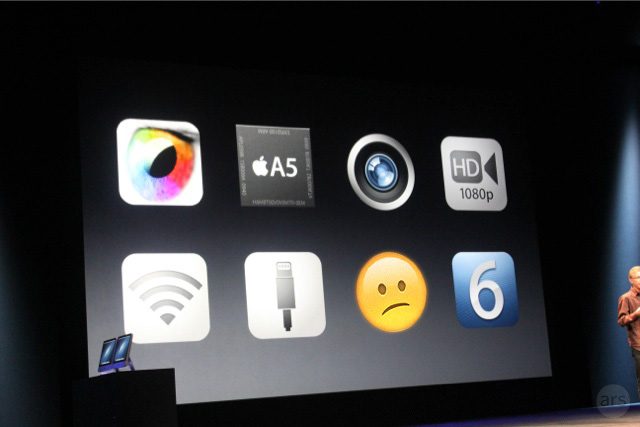
With the launch of the iPhone 5 this Wednesday, the big question is whether it's worth upgrading. Many of the new features—the camera specs, the design, probably the processor—impressed us, and some new features—the lack of simultaneous data and voice on Verizon and Sprint, and the lack of global roaming on AT&T iPhones—left us ever-so-slightly disappointed.
While there's no doubt that Apple put forth a good showing in the "new stuff" department, there were a couple of features that we were expecting that didn't make the cut. We asked Ars readers what you really wanted from a new iPhone the day before the launch, and you listed things like NFC, wireless charging, and standardized Micro USB. Almost nothing in that list was included when the iPhone 5 materialized. We're not angry, just disappointed.
Whither USB 3.0?
Apple updated its dock connector for the first time in nearly a decade yesterday, and the new eight-pin "Lightning" connector is definitely smaller and more attractive than the 30-pin version. Except for the part where it's incompatible with every one of the millions of iPod and iPhone accessories out in the wild today, it looks to be a solid improvement on what came before. In true Apple fashion, the company will sell a set of adapters to 30-pin connectors and micro-USB connector, and has plans to announce two different video adapters in the near future that it will certainly make a killing on.
And the transfer technology powering Lightning isn't Thunderbolt or even USB 3.0, but the 12-year-old USB 2.0 instead. Indeed, Lightning as it is today isn't even capable of USB 3.0 connectivity, which requires nine pins all by itself. There are plenty of technical reasons why faster connectivity options didn't make it into the new iPhone—both Thunderbolt and USB 3.0 would require additional controller hardware, either separate from or integrated into the SoC, and space is at a premium in all of Apple's ever-thinner devices—but it's a shame that people still transferring music and movies to their iPods and iPhones from their computers will still have to put up with yesteryear's poky transfer speeds.
When one wire is too many
Apple didn't include any wireless charging options in its iPhone 5, and that's a bit disappointing. All Things D reported that Apple Senior VP Phil Schiller wasn't sold on wireless charging because, "the wireless charging systems still have to be plugged into the wall, so it’s not clear how much convenience they add. The widely-adopted USB cord, meanwhile, can charge in wall outlets, computers and even on airplanes."
But just because wireless charging doesn't work for every situation doesn't mean it wouldn't be immensely useful in some situations. In a situation where lots of people need to charge their phones in a space with not a lot of outlets (many of us have lived in old houses with many roommates that fit this bill), throwing a couple phones on an inductive charging pad is a great convenience. And, just because a phone is inductive-charge capable, doesn't mean you wouldn't still plug phones into the wall, a computer, or on an airplane. Heck, selling a wireless charging pad would even give Apple a reason to sell a proprietary accessory at a price just north of what the average person is comfortable paying, as usual!
NFC's not just for wallets
We would have liked to see Near Field Communication show up. Apple's contention that Passbook does everything that customers could possibly want is unfortunately just not right. Passbook may fit the bill for buying concert tickets, but NFC is good for a lot more than pure point-of-sale applications. For one, a clever NFC implemenation could make swapping contacts or pictures almost a Minority Report-like affair—position the two phones near each other, bring up your contacts, and flick one from your phone to your friend's phone. This would be even better for photos—the new sharing-centric implementation of Photo Stream is certainly nice, but direct device-to-device sharing would be even more convenient.
We're not sure if we should even mention doing the same with music and videos, lest the RIAA and/or MPAA decide to kick down our doors and drag us to Movie Jail, but the application is obvious there as well, with NFC used to quickly establish a high bandwidth ad-hoc network between the two phones. It would be a reincarnation of the old Zune "squirt" technique, except without the horrible name and ridiculously bad DRM.
Everything but the kitchen sync
We're still waiting for some equivalent of Palm's conduit. Now, it's all explicitly about sharing documents, either manually via iTunes, or through iCloud. But Apple's first-party apps like iCal and Contacts just have a store that gets synced whenever you sync. We'd love to see an equivalent capability opened up to third party developers. It should be very, very easy for sandboxed apps. But it doesn't look like it's going to happen.
Look ma, no straps!
The new fifth-generation iPod Touch finally got the camera hardware it needs to be a decent point-and-shoot, and to that end Apple saw fit to give the device a neat little retractable peg for use with a wrist strap, to make the new iPod easier to use as a camera without dropping it. However, the new iPhone (which is an even better point-and-shoot) lacks any such peg, meaning that you'll have to continue to rely on third-party cases to supply this functionality if you want it.
There were several other things that Apple didn't include in the new iPhone that we didn't expect it to include, but we at Ars dared to dream: an 802.11ac chip, a phone without a home button, FM radio support, fingerprint scanners, to name a few features. The iPhone 5's actual specs are still nice. And considering Apple sold out its available stock within an hour on Friday morning, we're guessing none of these omissions were too terribly devastating to users.
reader comments
293